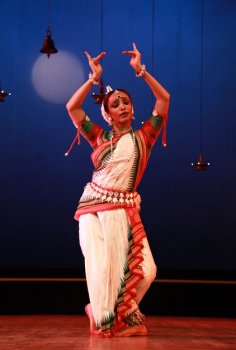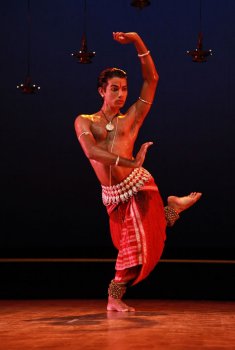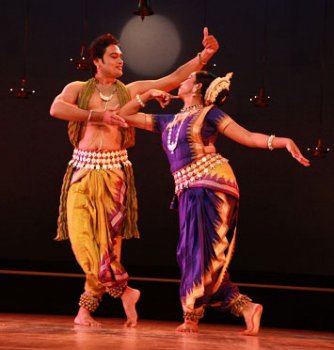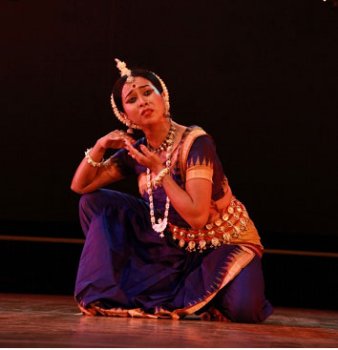
|   |

|   |
Naman 2013: An odyssey of grace, style and aesthetics - Satish Suri e-mail: satishism@yahoo.co.in Photos: Shandilya Srivatsa August 15, 2013 Nrityanthar Academy of Performing Arts, the organization spearheaded by Odissi dancer Madhulita Mohapatra, presented ‘Naman’ on 28th July at ADA Rangamandira, Bangalore. The presentation dedicated to the memory of the renowned Odissi dance Guru Murlidhar Majhi, showcased three distinctive styles of Odissi. Pavitra Reddy from Nrityagram provided a vibrant start to the program with “Sreedevi” saluting the mother goddess through shlokas from compositions of Shankaracharya. You are the supreme mother, who destroyed the evil Mahishasura, Chanda and Munda to protect us. Adapting the composition “Ai Giri Nandini” with music composition by Raghunath Panigrahi and choreography by her guru Surupa Sen, gave the artiste ample scope to display her virtuosity in enacting the sancharis and the kinetic movements of the composition. Her meticulous footwork interspersed with the tribangha and chowka postures coincided with perfect synchronization of rhythm and tala of the composition bringing cheers from her many admirers in the audience. The second piece was “Sunn maiya,” a composition of Surdas with music by Pt Jasraj, wherein the gopi complains to Yashoda that little Krishna has become a menace, that he stole her clothes when she was bathing in the river and that he had tied her long braid to the bed, scratched her body showing the telltale marks and stole all the butter. Little Krishna explains to his mother about his innocence. Yashoda decides that her son is innocent, “Look at him, he is only five years old, his hands are tiny and his finger nails soft and incapable of any harm. I have seen you flirting with the cowherds and the marks on your body must have come from one of them” and reprimands the gopi. Pavitra explored this piece with evocative expressions and grace, with the indelible footprint of her intense training at Nrityagram making its presence on stage.  Pavitra Reddy  Rahul Acharya Rahul Acharya from the Guru Debaprasad School, who performed next mesmerized with his sublime artistry. ‘Sthayi’ in raag Shankarabharanam originally choreographed by Guru Debaprasad Das and reworked by Guru Durga Charan Ranbir, was marked by pure nritta encompassing balance, grace and brilliance in the delineation of the sculptural postures. The graceful tribanghi had the charm of stately masculinity and the stances marked by precise and the larger than life expressions left a sense of awe among the audience. In the Jayadeva ashtapadi “Priye Charusheele” the emotive prowess of Rahul came into being depicting Lord Krishna trying to appease a visibly hurt and angry Radha. It had a measured grace and his abhinaya was impressive and full of conviction. In the next piece ‘Ashta Shambho’ (Eight verses in praise of Lord Shiva) choreographed by Guru Debaprasad Das, Rahul performed the seven tandavas with brilliant footwork, bhava and abhinaya. It was the crowning glory of his presentation. Be it the Ananda Tandava, Gauri Tandava, Sandhya Tandava, Kaaleeka Tandava, Uma Tandava, Tripura Tandava and Samara Tandava, they had all the markings of an accomplished and dynamic artiste, which left no one in doubt as to why he is rated so high as a performer  Ramesh Chandra Jena and Madhusmita Mohanty  Madhusmita Mohanty The finale was by the dance couple Ramesh Chandra Jena and Madhusmita Mohanty from Orissa. They presented ‘Navarasa’ in which each rasa was depicted through an episode from the Ramayana, reflecting the facets through the life of Rama - Veera (The breaking of the divine bow), Shringara (the joy of Rama and Seetha), Hasya (Soorpanaka’s nose being cut off), Bhayanaka (Sita’s abduction), Karunya (episode of Jatayu), Adbhuta (Sethu bandha), Bibhatsa (the bodies lying on the battlefield), Raudra (Rama’s battle with Ravana), Santham (the joy of victory and the peace that followed). The couple matched each other to perfection in delineating this piece with elegance and sentimental sensitivity. The final item of the evening was a solo by Madhusmita Mohanty. In the poem ‘Barabadhu’ by Dr. Mayadhar Mansingh, the hero returns to be met by a silent heroine. “Do you really love me?” he asks. “I have travelled all over and returned to share my inner yearnings. Why are you immersed in deep silence? Remove the veil so that our eyes can meet. Talk to me,” he says. Poignantly portrayed with varied facial expressions and providing the necessary impact to the abhinaya, Madhusmita did ample justice in this presentation bringing the curtains down to a colourful evening of Odissi dances. Madhulita Mohapatra who made this possible should be complimented for her untiring efforts and the presentation ceremony which had more than fifteen guests of honour was brief and pleasant and in no way taxing the time and patience of the audience. The compere Anjali Raj Urs did an excellent job of presenting this program with erudition and sophistication. Satish Suri has been an ardent follower of dance and music for more than 40 years, starting with being on the committee of the International Music and Arts Society founded by Vijaya Devi, sister of the Late Maharaja of Mysore, Jayachamarajendra Wodeyar and now presently is treasurer of World Dance Alliance Karnataka Chapter. He has presented several artistes, both dancers and musicians, over the last 40 years. |